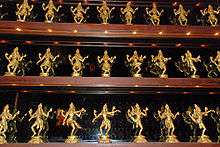Karana (dance)

Karanas are the 108 key transitions[1] in the classical Indian dance described in Natya Shastra. Karana is a Sanskrit verbal noun, meaning "doing".
Description
Natya Shastra states that Karanas are the framework for the "margi" (pan-Indian classical) productions which are supposed to spiritually enlighten the spectators, as opposed to the "desi" (regional folk or pop dance) productions which can only entertain the spectators. "One who performs well this Karana dance created by Maheswara will go free from all sins to the abode of this deity" states Natya Shastra [2]

Some of the well-known interpretations of karanas are by Padma Subramanyam that were based on 108 brief movement phrases describing specific leg, hip, body, and arm movements accompanied by hasta mudras described in the Natya shastra and other scriptures, and from depictions of the movements in sculpture in five South Indian temples, notably the Chidambaram temple which contains depictions of the full set. Dr. Padma Subrahmanyam has written a book called Karanas-Common dance codes of India and Indonesia, based on her research of karanas from the temples of Prambanan(Indonesia), Thanjavur, Kumbakonam, Chidambaram, Thiruvannamalai and Vriddhachalam. In the 20th century she was the first dancer to reconstruct the Karanas as movements, which were considered to be mere poses earlier.
Some other Bharatanatyam gurus, such as Adyar Lakshman (Kalakshetra school) as well as the Kuchipudi gurus Vempati Chinna Satyam and C.R.Acharya have also attempted to reconstruct all the 108 karanas, which were often significantly different from Padma Subrahmanyam's interpretations so much so that even on the chari (leg movement) level there was no agreement as to whose interpretation is correct. Due to the significant variations in the depictions, most traditional Bharatanatyam schools considered Padma Subrahmanyam's style which incorporated Karanas as incorrect, which forced her to name her own style as Bharatanrityam rather than Bharatanatyam. Many of Padma Subrahmanyam's disciples such as Sujatha Mohan (Padmashree Nrithyalaya), Uma Sriram, Jayashree Rajagopalan and others are teaching the 108 karanas based on Dr. Padma's research.
While recently there used to be devadasis who perform all the 108 karanas, in most contemporary Bharatanatyam or Odissi schools only a small number of karanas and their derivatives have been transmitted by parampara up to date.
Apart from that, performing of the same karana differ greatly across different classical Indian styles. Currently, as regards the exact technique, there are no established standards and no universally agreed upon interpretations of the texts and sculptures.
List of 108 Karanas
1) Talapuṣpapuṭam 2) Vartitam 3) Valitōrukam 4) Apaviddam 5) Samanakam 6) Līnam 7) Swastikarēchitam 8) Manḍalaswastikam 9) Nikuṭṭakam 10) Ardhanikuṭṭam 11) Kaṭīchinnam 12) Ardharēchitam 13) Vakśaswastikam 14) Unmattam 15) Swastikam 16) Pṛṣṭhaswastikam 17) Dikswastikam 18) Alātam 19) Kaṭīsamam 20) Ākśiptarēchitam 21) Vikśiptākśiptam 22) Ardhaswastikam 23) Añchitam 24) Bhujangatrāsitam 25) Ūrdhvajānu 26) Nikuñchitam 27) Mattalli 28) Ardhamattalli 29) Rēchitanikuṭṭam 30) Pādāpaviddakam 31) Valitam 32) Gūrṇitam 33) Lalitam 34) Daṇḍapakśam 35) Bhujangatrastarēchitam 36) Nūpuram 37) Vaiṣākharēchitam 38) Bhramaram 39) Chaturam 40) Bhujangāñchitam 41) Daṇḍarēchitam 42) Vṛśchikakuṭṭitam 43) Kaṭībhrāntam 44) Latāvṛśchikam 45) Chinnam 46) Vṛśchikarēchitam 47) Vṛśchikam 48) Vyamsitam 49) Pārśvanikuṭṭakam 50) Lalāṭatilakam 51) Krāntam 52) Kuñchitam 53) Chakramaṇḍalam 54) Urōmaṇḍalam 55) Ākśiptam 56) Talavilāsitam 57) Argaḷam 58) Vikṣiptam 59) Āvartam 60) Dōlāpādam 61) Vivṛttam 62) Vinivṛttam 63) Pārśvakrāntam 64) Niṣumbhitam 65) Vidyutbhrāntam 66) Atikrāntam 67) Vivartitakam 68) Gajakrīḍitam 69) Talasamsphoṭitam 70) Garuḍaplutam 71) Gaṇḍasūchī 72) Parīvṛttam 73) Pārśvajānu 74) Gṛdrāvalīnakam 75) Sannatam 76) Sūchī 77) Ardhasūchī 78) Sūchīviddham 79) Apakrāntam 80) Mayūralalitam 81) Sarpitam 82) Danḍapādam 83) Harinaplutam 84) Prēnkōlitam 85) Nitambam 86) Skalitam 87) Karihastam 88) Prasarpitam 89) Simhavikrīḍitam 90) Simhākarṣitam 91) Udvṛttam 92) Upaśṛtam 93) Talasanghaṭṭitam 94) Janitam 95) Avahittakam 96) Nivēśam 97) Ēlakākrīditam 98) Ūrūdvṛttam 99) Madaskalitam 100) Viṣṇukrāntam 101) Sambhrāntam 102) Viśkhambam 102) Udghaṭṭitam 104) Vṛśabhakrīḍitam 105) Lōlitam 106) Nāgāpasarpitam 107) Śakaṭāsyam 108) Gangāvataranam
See also
References
- ↑ ""108 Karanas: The Karanas are synchronized movement of hands and feet"". Site.voila.fr. Retrieved 2012-05-09.
- ↑ Natya Shastra translated by Manomohan Ghosh 2002 Chowkhamba Press, Varanasi ISBN 81-7080-079-X - Page 75.
External links
- Padma Subrahmanyam, "Bharatha Natyam - Classical Dance of the Ancient Tamils. The Role of Dance Sculptures in Tamilnad (1968) P. Subrahmanyam's introduction, with pictures illustrating 108 karanas.